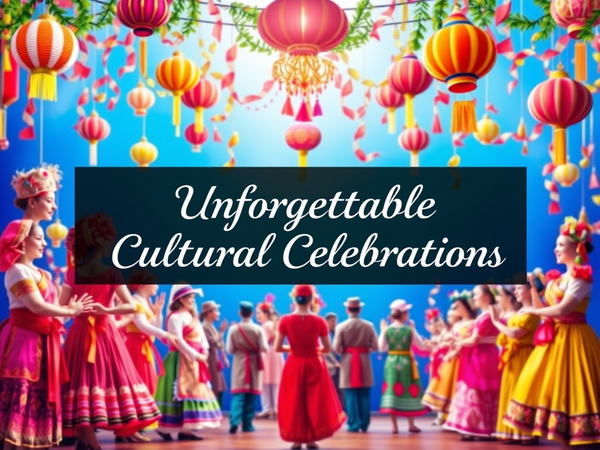5 Unforgettable Cultural Celebrations to Experience Globally

Celebrations are indicative of what people believe in a society, the history, and the people's sense of belonging. Celebrations provide participative experiences to share and enjoy your culture while being hospitable to newcomers.
With joyous dancing and somber rituals, the festivals bring people together worldwide. Discover five celebrations to experience amazing travels, make memories, and learn about culture.
Holi: The Festival of Colors (India)
Celebration of Holi in March, the India Festival. Also referred to as the Festival of Colors, it is made up of participants throwing colored powders and water at each other. It originated in Hindu stories, such as those of Prahlad and Holika, and represents the strength of devotion and triumph of goodness. The festival starts with Holika Dahan, a bonfire on the night before Holi. This symbolizes the burning of negativity. The next day, people congregate in public spaces, happily engaging in throwing colored powders and spraying water.
The participants consume traditional sweets such as gujiya and beverages such as thandai, while music and dance create an environment of excitement. Holi is characterized by its colorful celebration, bringing people of all ages, sexes, and backgrounds together in an environment of enjoyment. Cities such as Mathura and Vrindavan, sites of importance to Lord Krishna, welcome week-long celebrations drawing people from all over the globe.
These locations, which are steeped in folklore, music, and cultural customs, elevate Holi above other celebrations. These locations are preferred by tourists seeking genuine observances. Being a part of the culture and taking part in the festivities is more important than just snapping pictures during Holi. It provides an opportunity to observe how traditional stories still shape contemporary celebrations. Historians and culture vultures alike like the story of Holi, which is one of faith, courage, and happiness.
Carnival: A Festivity of Life (Brazil)
Rio de Janeiro's Brazilian carnival is considered one of the world's most exceptional cultural spectacles. The rich culture of Brazil is represented by this carnival, which takes place before Lent and combines Catholic, African, Portuguese, and indigenous traditions. Carnival started as a happy celebration to have before the fasting period called Lent. In today's world, it has become a joyous occasion to celebrate music, dance, and art. Samba schools compete at Rio's renowned Sambadrome.
Presenting stories ranging from mythology to social problems, dancers in colorful costumes perform on elaborately adorned floats. The tremendous passion in every dance step and rhythm is reflected in the months of preparation that go into each performance. With street blocos, the city transforms into a party destination outside the Sambadrome, drawing millions of revelers. Salvador and Recife carnivals are renowned for their vibrant atmosphere and exhilaration, showcasing lively music and dance genres known as axé and frevo. Carnival brings people together and showcases cultural pride, whether they are dancing at street parties or watching the parades. It is not a party, but a carnival of Brazil's strength, variety, and euphoria.
Carnival displays the artistic abilities of dancers, musicians, and costume designers. To get ready for their unique time at the event, many of them put in a year of nonstop labor. Carnival is more than a mere joyful celebration; it offers tourists a genuine experience of the culture of Brazil. It promotes involvement, admiration, and getting to know a community that uses celebration to honor its strength. By way of samba music, Carnival delivers you to Brazil and creates a celebratory, welcoming mood.
Día de los Muertos: Remembrance Rituals (Mexico)
The Day of the Dead, or Día de los Muertos, is a vibrant Mexican festival celebrated on November 1st and 2nd. This event is used to commemorate and honor the cherished departed. Contrary to somber Western views of death, this celebration honors life and fond memories. With Catholic practices, it mixes Aztec cultural traditions. Families build altars known as ofrendas. These altars are adorned with marigolds, candles, food, photographs, and personal belongings of the deceased.
This activity is designed to welcome spirits for a temporary reunion. With storytelling, music, and food, cemeteries transform into lively spaces that reflect the acceptance of death as a natural part of life. As a well-groomed skeleton, the portrayed figure La Catrina represents the perception that death comes equally to all individuals, irrespective of their socioeconomic status. Both locals and visitors attend parades and other community events held in places like Oaxaca and Mexico City. Large puppets, traditional dancers, and intricately painted faces are all part of these festivities, which blend artistic expression with reverence for religion. Traditional foods such as sugar skulls and pan de muerto (bread of the dead) are eaten during this time.
With Mexican tradition on the Day of the Dead, they can build a good rapport. Celebration and commemoration rituals cannot be divided from one another, bringing the dead into our narrative. Performing these traditions is a paradigm of core Mexican values of community, toughness, and family unity. This celebration shows how a nation welcomes death not in fear, but rather with color, celebration, and respect. For history and culture buffs, Día de los Muertos is the perfect celebration to exchange cultural pride and common memory.
Oktoberfest: A Toast to Tradition (Germany)
The world's largest beer festival, the Oktoberfest, is held in Munich, Germany, and is a joyous celebration of Bavarian hospitality, culture, and history. In 1810, the celebrations commenced to commemorate the marriage of Crown Prince Ludwig and Princess Theres. With more than six million visitors per year, Oktoberfest has become one of the largest events that runs for 16 to 18 days. The Oktoberfest is celebrated in the Theresienwiese district of Munich, which is famous for its tents of local breweries.
People choose to drink the specially brewed Oktoberfest beer, available in 1-liter mugs in these tents, accompanied by roast chicken, sausages, and pretzels. German culture is also celebrated through parades, folk music, dances, and carnival rides alongside beer. By wearing traditional Bavarian attire such as dirndls and lederhosen, visitors add to the festival's authenticity and make the event more vibrant. The audience watches the procession as horses and brass bands lead the wagons through the streets. When the mayor of Munich taps the initial beer barrel, a historical celebration commences. Later in the week, families are indulged in serene activities that host cultural presentations and fun activities for kids.
Individuals come from all corners of the globe to enjoy Oktoberfest, a massive festival that brings together people, culture, and happiness. It provides guests from various countries with an opportunity to discover German culture in a welcoming and lively environment. Going to Oktoberfest is not just about drinking beer; it is about nostalgia, meeting new people, and experiencing Bavaria's festive atmosphere. Oktoberfest provides beer, music, and a friendly atmosphere that celebrates the best of German culture.
Naadam Celebration: The Games of the Mongols (Mongolia)
Each summer, Naadam, Mongolia's biggest cultural festival, takes place throughout the country. The exciting Naadam festival in the capital city, Ulaanbaatar, features horse racing, archery, and wrestling, termed the "Three Manly Games." These activities are important, considering Mongolia's past of nomadic existence and martial ways. The festival celebrates Genghis Khan's history and honors the independence of Mongolia, showing patriotism toward the nation and an affinity with the past.
A colorful parade with music, dance, and athletes in traditional attire is a component of the grand opening of the National Stadium. The most distinctive element of Naadam is wrestling, which is done in traditional attire and consists of gestures that pay tribute to conquest and heritage. Unlike their Western counterparts, horse racing entails children racing over broad-open spaces. It retains perseverance in addition to the strong relationship between Mongolians and their horses. Everyone utilizes regular bows in archery competitions. These tournaments are about accuracy and calmness. The festival of Naadam may be a time for Mongols to join together in euphoric celebration.
They share stories of family lore, have tasty food such as khuushuur, and wear colorful traditional clothes. Activities in rural Naadam, which often include sports along with local music and locally made products, are a more intimate and real experience. Naadam provides visitors with a profound insight into the nature of Mongolia by presenting its ancient traditions alongside modern developments. It is an interesting experience involving a culture that respects its past, traditions, and nature. It is a story of national pride, strength, and unity, Naadam is not merely a game. For history and culture lovers, it is a thrilling event that includes traditions with much pomp and pageantry.
Conclusion
Cultural celebrations are not so much parties, but the beating heart of communities. From Naadam's historical traditions to the colorful celebrations of Holi, every celebration brings history, identity, and value to the front.
Seeing these things for ourselves creates empathy, increases understanding between people, and increases appreciation of different expressions. For travelers and history buffs alike, these celebrations are incredible highlights of the history of the world.








